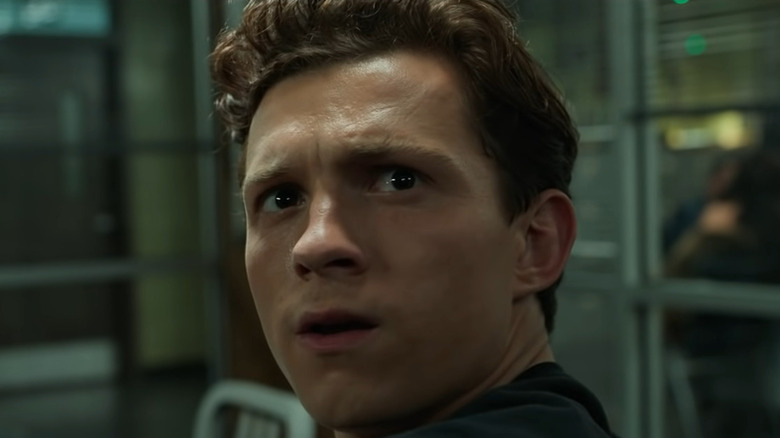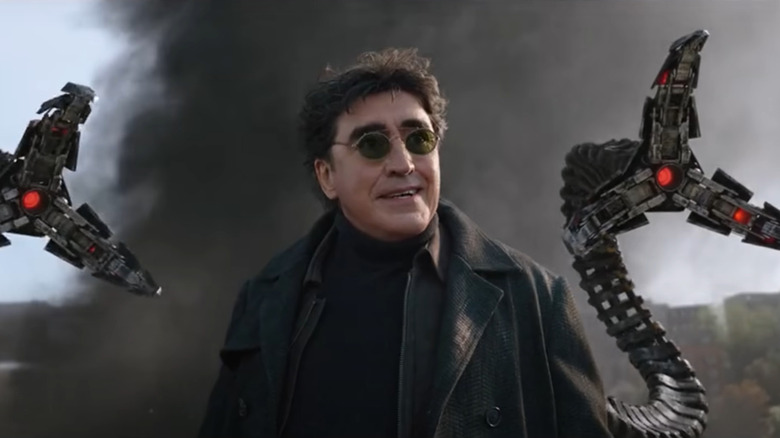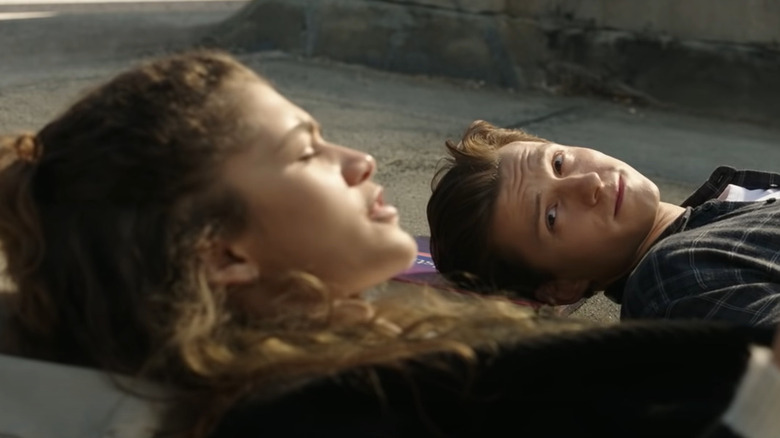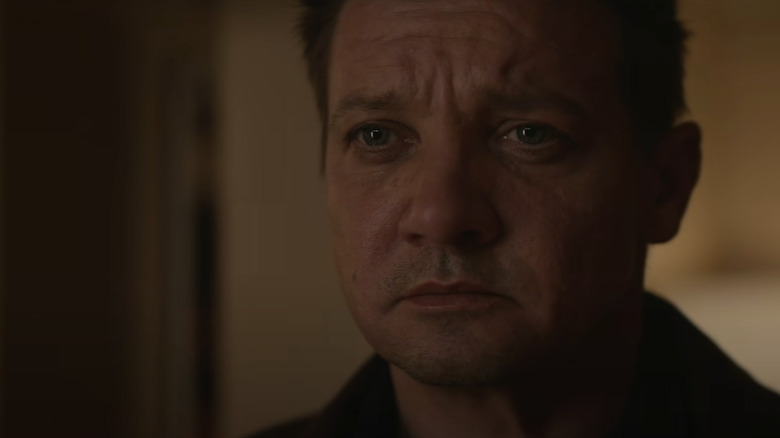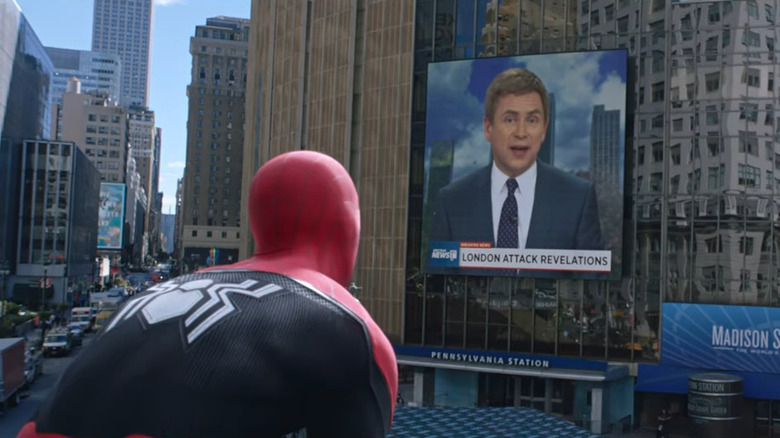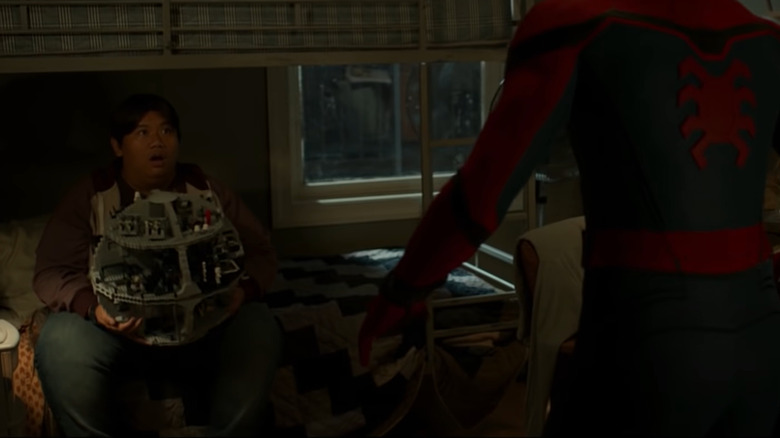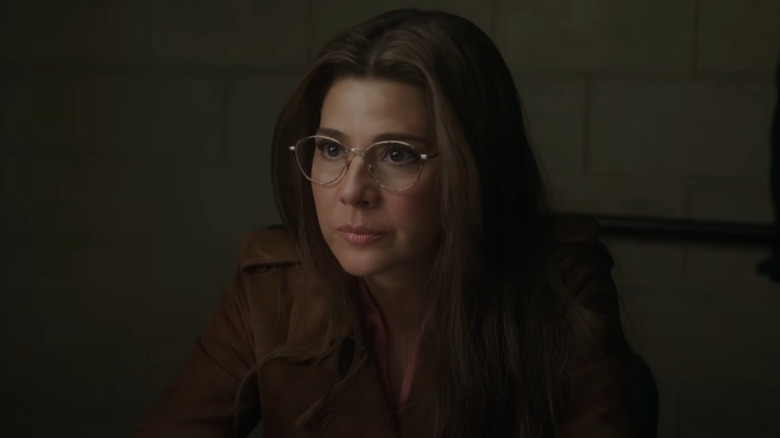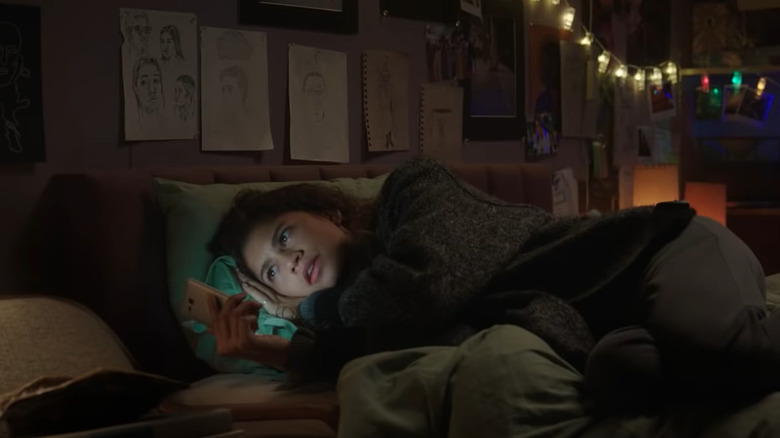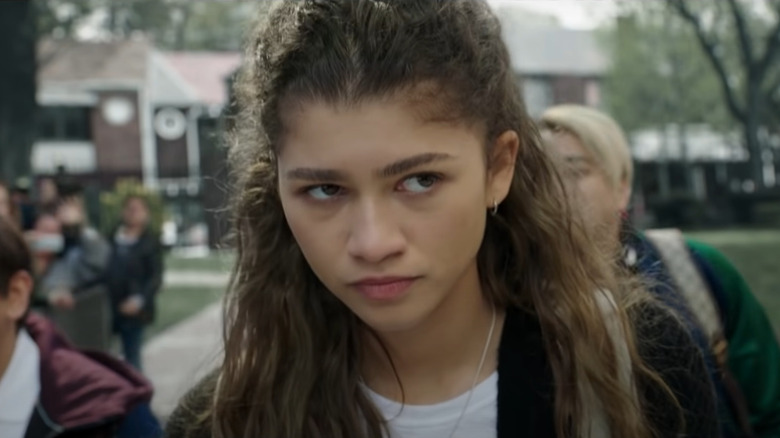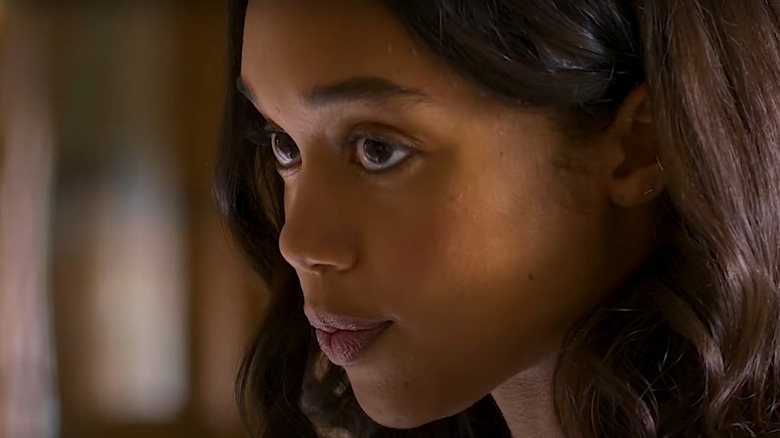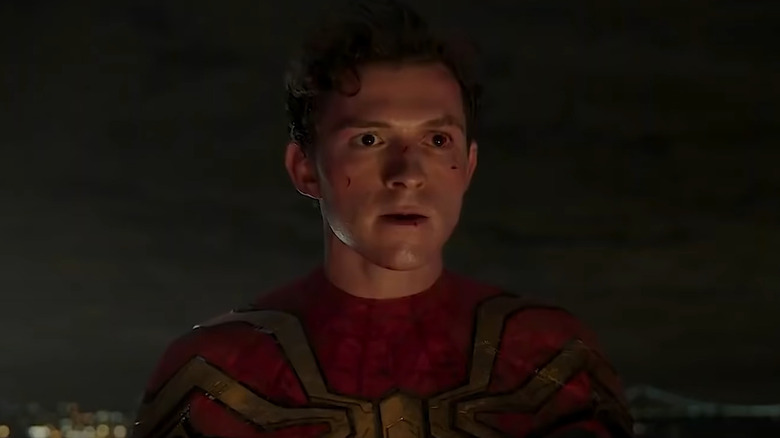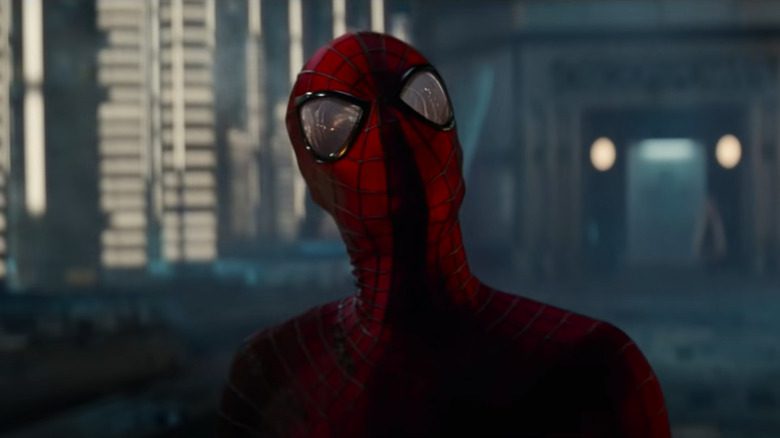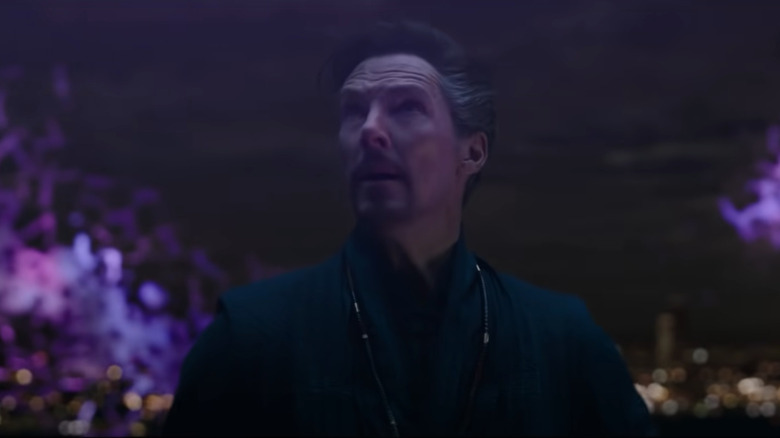Things You Only Notice In Spider-Man: No Way Home After Watching It More Than Once
With 2021's "Spider-Man: No Way Home," Marvel Studios not only managed to wrap the perfect bow around the first trilogy of Tom Holland's "Spider-Man" films, but also managed to add a nice little coda to both Tobey Maguire's (mostly) beloved "Spider-Man" series and to Andrew Garfield's two, well, less beloved "Amazing Spider-Man" films. While "Spider-Man: No Way Home" could've ended up as simply fan-service, it delivered plenty of humor and heart with the amazing action and visual effects, adding up to a truly crowd-pleasing experience.
Marvel Studios is known for packing each of its films and TV series with Easter eggs, and "Spider-Man: No Way Home" is no exception. However, one of the aspects of this film that sets it apart from the other entries in the Marvel Cinematic Universe is that it has previous versions of the character. As such, only does "Spider-Man: No Way Home" reference the wider MCU and the comic book source material, but also previous incarnations of Spider-Man and their respective universes. There are so many hidden details in this film that it's impossible to catch them all in only one sitting, so here are some things you only notice in "Spider-Man: No Way Home" after watching it more than once.
Those license plates mean more than you think
There's a car in the film that has a license plate with the numbers "1228." This is actually a hidden tribute to the late, great Stan Lee, whose birthday is December 28. Lee helped create Spider-Man, along with many other characters in the movie. Famous for appearing in nearly every Marvel Studios film, Lee sadly passed away on November 12, 2018, before he could make an appearance in "Spider-Man: No Way Home." The reference in the film is a great way to pay homage to an important creator whose work has so greatly influenced one of the most successful franchises of all time.
Another license plate seen in the film has a deeper meaning: During the scene when Peter Parker tracks down the assistant vice chancellor from MIT on the bridge, the license plate on her car reads "63ASM-3," which is a reference to issue #3 of "Amazing Spider-Man" released in 1963. But why reference this issue in particular? It's the very first appearance of Otto Octavius aka Doctor Octopus. Fittingly, the license plate is depicted in the scene that features the character's very first appearance in the Marvel Cinematic Universe.
And that graffiti means more than meets the eye
The rooftop of Midtown School of Science and Technology was an important location in "Spider-Man: No Way Home," serving as a sort of sanctuary for Peter that allows him to get away from the craziness of the world. There's some graffiti on the wall in the background during the scenes that take place on the rooftop. While the graffiti may seem like what you'd typically see in some high schools, this graffiti is special as it spells out "Ditko." For those not familiar with comic book history, this is a reference to Steve Ditko who, along with Stan Lee, created such classic characters as Spider-Man, Doctor Strange, and many others.
In fact, Ditko has played an important part in Marvel history. He began as an artist there in 1955 when the company was still called Atlas Comics (they would rebrand as Marvel Comics in 1961) and worked on a wide number of comics, like "Journey into Mystery," "Strange Tales," and "Tales to Astonish." He eventually went on to do the art for issue #15 of "Amazing Fantasy," which featured the first appearance of Spider-Man. The issue was so popular that it quickly led to the character getting his own series, which Ditko drew for its first thirty-eight issues.
There's a connection to the Disney+ series Hawkeye
So many of the film's Easter eggs are in the background, making them easy to be glossed over by even the most eagle-eyed of fans. One of those Easter eggs was the billboard for "Rogers: The Musical," seen in Times Square. It's one of several references to Steve Rogers aka Captain America throughout "Spider-Man: No Way Home," including the renovation of the Statue of Liberty that consists of a massive red, white, and blue shield. While the completed statue of Rogers hasn't been revealed yet, it's still fun knowing that the world continues to honor his legacy.
However, the billboard for "Rogers: The Musical" isn't just a reference to Captain America; it's also a reference to the Disney+ series, "Hawkeye." At the beginning of the series, Clint Barton aka Hawkeye takes his children to New York City to see the musical. He's left largely dissatisfied, not only for its historical inaccuracy (the musical included Ant-Man in the Battle of New York despite him not actually being present), but for bringing up memories of Natasha Romanoff aka Black Widow and her sacrifice to help save the world.
You've seen that news anchor before
No, we're not talking about J.K. Simmons as J. Jonah Jameson.
Pat Kiernan can be seen in "Spider-Man: No Way Home" as a news anchor of NY1. However, the lines between fiction and reality begin to blur here, as NY1 is a real cable news television channel, and Kiernan is a real news anchor for NY1. But if you haven't seen him on TV in real life, you've probably seen him on the big screen before, as he's appeared in various other Marvel projects as himself, including "The Avengers," "Iron Man 3," "Daredevil," "The Punisher," "Hawkeye," "Doctor Strange," and "Spider-Man: Far From Home." Having such a long history with New York City, it makes sense that Marvel would turn to him to report on superheroics that constantly take place in the Big Apple.
Kiernan has a real-life reputation for recapping the more interesting goings-on in New York City in a droll manner in his feature, "In the Papers," making him the perfect figure to summarize the often otherworldly occurrences that are typical in the Marvel Cinematic Universe.
What's the deal with that Death Star Lego set?
Because Disney owns both the Marvel and "Star Wars" film franchises, it only makes sense for there to be the occasional crossover. While we've yet to see any Marvel references in any "Star Wars" projects, there've definitely been some "Star Wars" references made in Marvel films. One of those nods to "Star Wars" was in the form of the Death Star Lego set that Peter's seen working on during the college rejection letter montage.
But what's the significance of that Death Star Lego set that you might not have noticed on your first watch of "Spider-Man: No Way Home"?
Well, if you remember in "Spider-Man: Homecoming," Peter and his friend Ned Leeds make plans to work on that very set together. In fact, when Ned discovers that Peter is Spider-Man, he accidentally drops the unfinished set on the floor and completely destroys it in a way that would make Luke Skywalker himself proud. And considering that particular set has more than 4,000 pieces, it's no wonder that it's taken Peter so long to rebuild it (Peter was a sophomore in "Homecoming" and is a senior in "No Way Home").
Aunt May and her job at FEAST
In "Spider-Man: No Way Home," Aunt May is seen working at FEAST (Food, Emergency Aid, Shelter and Training), a charitable organization. When Peter Parker inadvertently causes Doctor Strange's spell to go sideways and let in characters from other dimensions, Norman Osborn enters this universe and has a brief confrontation with Spider-Man. However, Osborn manages to contain his Green Goblin persona, and ends up at FEAST, confused and broken, leading Aunt May to convince Peter to help him.
FEAST may not seem like an important location, but it has actually shown up in other corners of the wider Marvel Universe. It's been seen in the comic book series, "Spidey" and "Friendly Neighborhood Spider-Man." However, its most notable previous appearance was in the video games, "Marvel's Spider-Man" and "Marvel's Spider-Man: Miles Morales." In fact, Aunt May also works at FEAST in this universe, which is where another Spider-Man, Miles Morales, decides to volunteer on Peter's urging. We've already gotten a couple of other references to Miles Morales in the Marvel Cinematic Universe; is FEAST how he'll finally make his MCU debut?
Recognize those drawings on MJ's wall?
Not enough is said about how much of a good girlfriend MJ is to Peter Parker, especially in "Spider-Man: No Way Home." Even when his real identity is revealed to the world and he becomes the center of its attention, she sticks by him and endures hardships that come with dating the most infamous person alive. In the scene where the two of them are video-chatting one night, she gives him some emotional support during his difficult time. But look a little closer at the wall behind her and you'll see it's covered in various pencil drawings. Do they look familiar?
In "Spider-Man: Homecoming," MJ reveals that she likes to go to detention even if she doesn't need to, just so she can have the opportunity to "sketch people in crisis." Among the drawings on her wall is that of Coach Wilson (Hannibal Buress), the one who notices her unnecessary attendance in detention, as well as that of a sad Peter Parker with a cloud over his head. It's a subtle yet revealing little detail about MJ; on the surface, she comes off as wry and aloof, yet she clearly has a sweet side to her.
MJ's job as a waitress echoes something we've seen before
Somehow, despite MJ's general aversion to people, she managed to get a job working at a coffee shop, where she ostensibly has to interact with and cater to people she doesn't even know. But if nothing else, it shows character growth, and it does give Peter Parker a reason to be inspired to reach out to Doctor Strange when he sees Halloween decorations hanging up at the coffee shop.
However, that's not the first time we've seen an MJ working in the hospitality industry in the Spider-Man universe. Kirsten Dunst's Mary Jane Watson was seen working as a waitress at the Moondance Diner in 2002's "Spider-Man," followed by her stint as a singing waitress at The Jazz Room in 2007's "Spider-Man 3." This could be a coincidence, but it's possible that having the MCU's MJ working as a waitress was intended to lend credence to the multiversal elements of the film, and how there are numerous similarities between the various universes.
Blink, and you'll miss Liz Toomes
Liz Toomes (played by Laura Harrier) is the Marvel Cinematic Universe version of Liz Allan, a popular girl that Peter Parker went to high school with and who has appeared as a supporting character in the comics. She made her film debut in "Spider-Man: Homecoming" as the girl Peter has a crush on. He eventually gets the courage to ask her out to the homecoming dance, to which she agrees. However, on the night of the dance, Peter discovers that her dad is Adrian Toomes — also known as the Vulture, the villain Spider-Man has been tangling with throughout the film.
After Liz's dad is apprehended for his crimes, she moves to Oregon with her mom and is never seen again in the MCU. At least, not in person. If you look closely during the scene when Doctor Strange is chasing Spider-Man around New York City, you'll spot a shop front with several newspapers in the window including the latest issue of "People" magazine featuring a cover with Liz on it. Next to the picture of her face are the words "He's a liar," referencing Peter's double life. Considering how the two ended things in such a shaky way at the end of "Homecoming," it's safe to assume she's even more bothered with him after learning the truth about him.
The three Spideys recreate that classic meme - twice
Even though it seemed that Tobey Maguire and Andrew Garfield returning to play their versions of Spider-Man for "Spider-Man: No Way Home" seemed like Hollywood's worst kept secret for over a year, it's still an absolute blast seeing the three Spideys share the screen together. Their interactions with one another were pure gold, from Maguire and Garfield's Spider-Men consoling their younger counterpart when Aunt May died, to the three of them nerding out together in the high school lab, to them taking on villains from the multiverse at the Statue of Liberty.
However, there's one more fan-favorite thing that the three Spideys did that you may have missed on your first watch, and that's the recreation of the classic meme of multiple Spider-Men pointing at each other. In fact, Maguire, Garfield, and Holland actually reenact that meme twice in "Spider-Man: No Way Home." The first instance was when the three of them are in the high school lab devising cures for the villains and Ned calls out "Peter," to which they all respond. When they're not sure who Ned's referring to, Ned clarifies by calling "Peter Parker," and they all point at themselves, then at each other, resulting in one of the more hilarious scenes in the movie. The second time is when they're on the Statue of Liberty and planning their attack and pointing at each other, but this time they're in their costumes, which more accurately mimics the meme.
Andrew Garfield is 'Peter Three' for a reason
Poor Andrew Garfield. "The Amazing Spider-Man" was a solid reintroduction of the character, even if many of its elements had already been done in Sam Raimi's previous trilogy, and "The Amazing Spider-Man 2" was ... considerably less well-liked than its predecessor. Meanwhile, despite being in a mediocre series whose plans for future installments fell apart, Garfield gave us a terrific performance as Peter Parker. And even though the second film's poor reception had a hand in Sony working with Marvel Studios to bring the character into the MCU, it was still a shame that Garfield never got the proper sendoff before handing the character over to Tom Holland.
Luckily, Garfield's appearance in "Spider-Man: No Way Home" got to serve as a nice final chapter for his time as Spider-Man. In fact, there's even a subtle nod to this that might have gone unnoticed during your first watch of the film. During the scene at the Statue of Liberty when the three Spider-Men coordinate their attacks on their villains, Holland points to himself and takes on the name "Peter One," then points at Tobey Maguire and designates him "Peter Two," and points to Garfield and calls him "Peter Three," which he reluctantly agrees to. Garfield is the only Spider-Man among them to not get a third chapter in his series, so this scene seems like a bit of a meta nod to the fact that he'll have to settle for "No Way Home" being his "number three" film.
Who are those silhouettes in the sky?
The multiverse has become a major part of the Marvel Cinematic Universe as of late, playing prominent roles in the Disney+ series "Loki" and "What If...?," and will be central to "Doctor Strange in the Multiverse of Madness." In "Spider-Man: No Way Home," Doctor Strange's attempts to make the world forget Peter Parker is Spider-Man goes awry, leading to various characters from other dimensions to land in the MCU. And when Doctor Strange is casting the spell to send everyone home during the final showdown, the sky cracks open and silhouettes can be seen.
Like most little details in the Marvel Cinematic Universe, there's much more to those figures who are about to enter Peter Parker's home dimension. It's easy to not recognize who those silhouettes belong to on the first and even second viewing of "Spider-Man: No Way Home," but true fans will notice that they're depictions of other Spider-Man villains, including Rhino, Scorpion, and Kraven the Hunter, among others. Rhino has appeared in "The Amazing Spider-Man 2" (played by Paul Giamatti); Mac Gargon (played by Michael Mando) appeared in "Spider-Man: Homecoming," though not as his Scorpion alter-ego; and Kraven the Hunter will be getting his own film by Sony, and will be played by Aaron Taylor-Johnson. Were those silhouettes just little teases for the fans, or are they hints of what's to come for Holland's Spider-Man?
